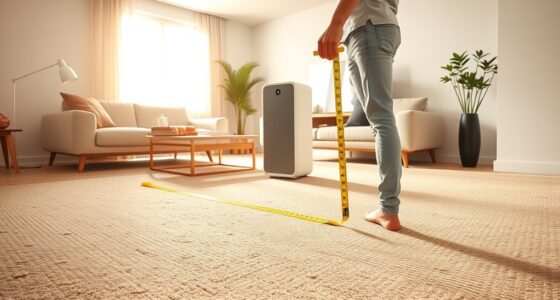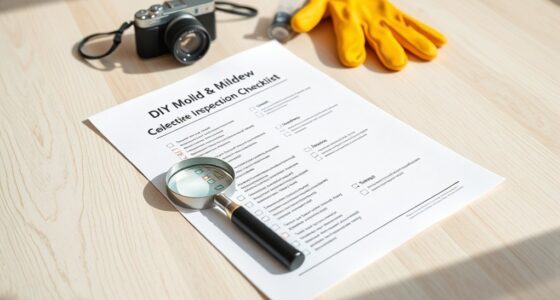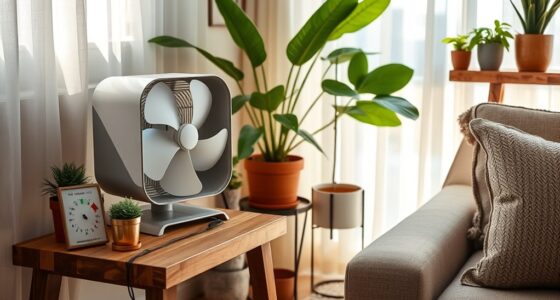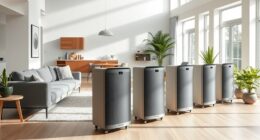To better manage asthma at home, keep your living space clean and dust-free by regularly vacuuming with a HEPA filter and washing bedding often in hot water. Use air purifiers to trap airborne allergens and pollutants, and keep windows and doors closed during high pollution or pollen days. Monitoring local air quality helps you plan outdoor activities, reducing exposure to triggers. Want to learn more about creating a healthier environment for your asthma?
Key Takeaways
- Regularly clean and dust your home with a damp cloth to reduce indoor allergens like dust mites and pet dander.
- Use HEPA air purifiers indoors to trap airborne allergens and pollutants, improving air quality.
- Keep windows and doors closed during high pollution or pollen seasons to prevent outdoor pollutants from entering.
- Wash bedding, curtains, and plush toys frequently in hot water to eliminate dust mites and pet allergens.
- Monitor local air quality reports and plan outdoor activities during low pollution or pollen periods.
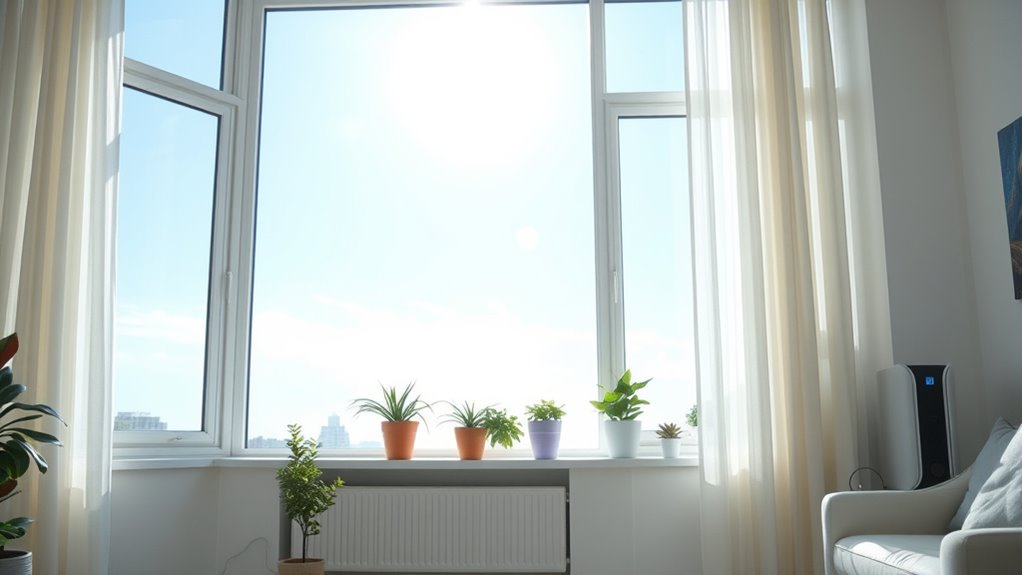
Have you ever wondered how the air you breathe affects your asthma? It’s a vital question because your environment plays an important role in managing your symptoms. Indoor allergens and outdoor pollution are two major factors that can trigger asthma attacks or worsen your condition. Understanding how these elements influence your air quality can help you take practical steps to breathe easier at home.
Indoor allergens are often overlooked but can be just as harmful as outdoor pollution. Dust mites, pet dander, mold, and cockroach droppings are common culprits that linger inside your home. These tiny particles can irritate your airways and set off asthma symptoms. To reduce indoor allergens, you should keep your home clean and well-ventilated. Regularly dust surfaces with a damp cloth to trap dust instead of spreading it around. Wash bedding, curtains, and plush toys frequently in hot water to eliminate dust mites and pet dander. If you have pets, consider designating certain areas as pet-free zones, especially your bedroom, to minimize exposure. Using high-efficiency particulate air (HEPA) filters in your HVAC system or portable air purifiers can also help trap airborne allergens, making the air safer to breathe. Being aware of GMC tuning techniques and tools can also contribute to maintaining a healthier indoor environment, such as ensuring your HVAC system is properly maintained and tuned.
Outdoor pollution is another important factor that impacts your asthma. Pollution from vehicle emissions, industrial activity, and pollen can enter your home through open windows and doors, especially on windy days. These pollutants can inflame your airways and make your symptoms worse. To mitigate outdoor pollution’s effects, keep windows and doors closed during high pollution days or when pollen counts are high. Using air purifiers equipped with HEPA filters can greatly reduce airborne pollutants inside your home. Additionally, check local air quality reports regularly and plan outdoor activities accordingly—preferably when pollution levels are low. If you need to go outside during high pollution days, wear a mask designed to filter out airborne particles and try to limit your outdoor exposure.
Balancing indoor air quality and reducing outdoor pollution exposure can make a noticeable difference in your asthma management. Simple actions like keeping your living space clean, using air purifiers, and staying informed about air quality conditions help minimize triggers. Remember, small adjustments can lead to a big improvement in your breathing and overall well-being. By actively managing your environment and staying aware of outdoor pollution levels, you can take control of your asthma and enjoy a healthier, more comfortable home.
Frequently Asked Questions
Can Air Purifiers Eliminate All Asthma Triggers Indoors?
Air purifiers can’t eliminate all indoor pollutant sources or asthma triggers, but they can help reduce airborne allergens and irritants. Keep in mind their limitations, like not removing all chemicals, dust, or mold. Regular cleaning and proper ventilation are essential, too. While air purifiers improve air quality, you should also minimize indoor sources of pollution to create a healthier environment for asthma management.
How Often Should I Replace Air Filters for Asthma Management?
When you notice your air filter looks dirty or it’s been about 90 days, it’s time for filter replacement. The air filter lifespan varies depending on the type and your environment, but generally, you should replace it every 1-3 months. Regular filter replacement keeps indoor air fresh and reduces asthma triggers. Coincidentally, maintaining clean filters helps your home breathe easier, supporting your overall health and comfort.
Are Natural Remedies Effective Against Indoor Air Pollutants?
Natural remedies like herbal teas and essential oils can provide some relief from indoor air pollutants, but their effectiveness varies. You might find that certain essential oils, such as eucalyptus or tea tree, help purify the air or ease breathing. However, they shouldn’t replace proven methods like good ventilation or air purifiers. Use herbal remedies and essential oils as complementary tools to support overall air quality and your asthma management plan.
What’S the Impact of Humidity Levels on Asthma Symptoms?
High or low humidity levels can worsen asthma symptoms. Maintaining proper humidity control helps prevent mold growth and dust mites, which are common triggers. You should aim for indoor humidity between 30-50%. Use a dehumidifier or humidifier as needed, and guarantee proper ventilation. This helps keep your air quality stable, reducing irritants that can cause asthma flare-ups. Focus on consistent humidity control and mold prevention to keep symptoms manageable.
Can Plants Improve Indoor Air Quality for Asthma Sufferers?
They say a breath of fresh air is worth more than gold. While indoor plants can be natural air purifiers, their benefits depend on the types you choose. Some indoor plants, like snake plants and pothos, can help improve air quality by filtering out toxins. Keep in mind, though, that plants alone won’t solve air quality issues, but they can be a helpful addition to your overall approach to a healthier home.
Conclusion
Taking control of your home environment is like steering a ship through calm waters—your choices directly influence your asthma. By monitoring air quality, avoiding triggers, and keeping your home clean, you create a safer space where breathing becomes easier. Remember, each small step is a brick in building a healthier space, much like a gardener tending to delicate plants. Stay proactive, stay informed, and breathe easier knowing you’re actively protecting your health every day.


